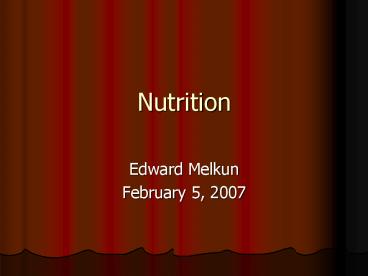Nutrition - PowerPoint PPT Presentation
1 / 16
Title:
Nutrition
Description:
Nutritional Assessment. History 10% weight loss or more suggests protein malnutrition ... Nutritional Therapy. Healthy adult approx 25 kcal/kg/day, 1g ... – PowerPoint PPT presentation
Number of Views:174
Avg rating:3.0/5.0
Title: Nutrition
1
Nutrition
- Edward Melkun
- February 5, 2007
2
Overview
- Nutrition plays key role in recovery
- Discussion of changes during critical illness
- Parenteral and Enteral Nutrition
3
Acute Phase Response
- Changes in AA metabolism
- Increased acute phase proteins
- Increased gluconeogenesis
- Fever
- Negative nitrogen balance
4
AA metabolism
- Cytokines and inflammatory mediators circulate to
liver - Inhibit albumin synthesis and increase acute
phase proteins (ex. CRP) - Also circulate to brain and act on hypothalamus
to increase core temp, and increase ACTH
5
Insulin Resistance
- Decrease in body glucose oxidation and increased
liver gluconeogenesis - Increased ketogenesis
- Rise in serum cortisol leads to insulin
resistance - Increased catecholamines, glucogon, and growth
hormone also lead to elevated serum glucose
6
Increased Catabolism
- Critically ill patients may lose 16-20g nitrogen
in the urine per day (nl is 10-12g) - 1g of urea equal to about 1oz. Of skeletal muscle
- May result in impaired respiratory muscle
strength, heart and gi function
7
Use of Proteins
- Leukocytes have decreased half life of 4-6 hours
during infection - Increased acute phase proteins
- Average critically ill adult can break down and
resynthesize 400g of protein in 24 hours.
8
Nutritional Assessment
- History 10 weight loss or more suggests
protein malnutrition - Exam Weight/Ideal body weight (lt85 predicted),
temporal muscle wasting, anthropometrics - Nutritional markers
- -daily weight more a measure of fluid status
than nutritional status - -24 hour urine urea nitrogen (cannot be used in
renal failure) - -albumin 21, prealbumin 2, transferrin 7
- -albumin influenced by fluid status, acute phase
- response
9
Nutritional Assessment
- Immune function skin testing, anergy
- Predictors of outcome -
- - albumin lt3.4 related to increased mortality in
VA study, linear correlation, APACHE III score
factors in albumin - - caloric intake predicts survival when matched
for serum albumin level
10
Nutritional Therapy
- Resting Energy Expenditure linked to lean body
mass - Accurate calculation can be done with metabolic
cart, estimated by Harris-Benedict - Adult males
- BEE (kcal/day) 66 (13.7 x wt in kg) (5 x ht
in cm) - (6.8 x age). - Adult females
- BEE (kcal/kcal) 655 (9.6 x wt in kg) (1.7 x
ht in cm) - (4.7 x age).
11
Nutritional Therapy
- Healthy adult approx 25 kcal/kg/day, 1g
protein/kg/day - Pretty sick to moderately sick 30 kcal/kg/day,
1.5g protein/kg/day - Very sick 35 kcal/kg/day, 2g
- Very Very sick - ? 40 kcal/kg/day, ?2.5g
12
EN vs. PN
- If the gut works, use it
- Prevents gut atrophy, translocation, reduced
infections, better maintenance of serum albumin,
reduced mortality despite equal caloric intake - Indications for TPN short gut, high output
fistula, hyperemesis gravidarum - Increased rates of infection and complications
may be due to failure to maintain tight glucose
control
13
Enteral Nutrition
- FT placement ideally in small bowel
- Theoretical decrease in incidence of aspiration
- CDC recommends feeding patients with HOB elevated
to reduce risk - Theoretical decreased risk in patients with
cuffed ET tube
14
Parenteral Nutrition
- 3 liters of fluid necessary to give enough
calories via PPN due to limitations on dextrose
content due to phlebitis risk - Dextrose administration should not exceed
3.5mg/kg/min to avoid metabolic complications - Fats Septic patients have decreased ability to
utilize dextrose, but use fats well - Also prevents essential fatty acid deficiency
15
TPN
- Complications associated with TPN include
increased serious infections including catheter
infection, venous thrombosis - Metabolic complications include
- Volume overload, Essential fatty acid deficiency,
Hyperglycemia, Trace mineral deficiency,
Refeeding syndrome, Vitamin deficiency,
Hypokalemia, Metabolic bone disease,
Hypophosphatemia, Hepatic steatosis
Hypomagnesemia, Hepatic cholestasis,
Hyperchloremic acidosis
16
TPN
- TPN given at supratheraputic caloric levels of
39kcal/kg/day and 1.8g/kg/day protein did not
show any anabolism or increase in lean body mass. - Still continued to lose 24g of nitrogen in
average day - Pts were able to increase fat stores
- TPN can slow catabolism but not increase anabolism































